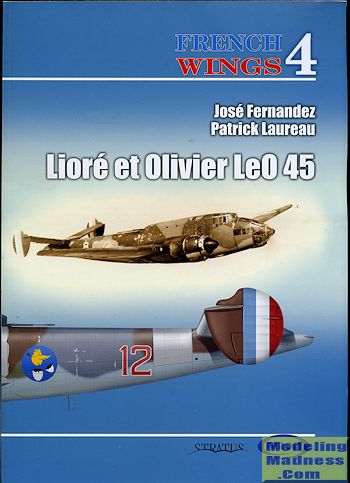 The LeO 45 series of planes were some of the most modern aircraft in the French
Air Force at the beginning of WWII. It was a sleek all metal aircraft with
a rather heavy defensive upper turret containing a 20mm canon. It was also built
in fairly large numbers and continued to be constructed for Vichy forces after
the June armistice.
The LeO 45 series of planes were some of the most modern aircraft in the French
Air Force at the beginning of WWII. It was a sleek all metal aircraft with
a rather heavy defensive upper turret containing a 20mm canon. It was also built
in fairly large numbers and continued to be constructed for Vichy forces after
the June armistice.
However, and there is always a however when talking
about the French aircraft industry of this period, the aircraft suffered from a
lack of really good engines and it also had stability issues. The engine
situation was never really fixed as it Gnome & Rhône 14 cylinder dual row
radials not only never produced a lot of power, but they were relatively
unreliable. This became even more of an issue under German occupation as
sabotage was frequent, leading to even more reliability problems. Then a factor
that affected all French aircraft construction was a lack of outside supplied
pieces like propellers, gyros, generators, and so on. It was not unusual to have
dozens of LeO 451s outside the factories awaiting these small parts so that the
airplane could be finished.
Still, it was a lot more modern than the Bloch and Amiot
bombers the Air Force had been using up until that time. As a result, the
aircraft had a fairly active if not less than totally successful career during
WWII and after. It flew many missions during May/June 1940 against both the
Germans and Italians. After the Armistice, it participated quite a bit in the
British incursion into the Levant and though many aircraft were lost (mostly on
the ground and due to equipment failures), they were effective against British
forces. They were also used briefly during Operation Torch and later with some
Free French units, though reliability and lack of spares resulted in ever
decreasing use. After the war, several of the surviving planes were re-engined
with P&W 1830s and some were also used as test beds.
In addition to the French Air Force, the French Navy
briefly used the type and it was used as a transport and liason aircraft by the
Germans.
The book offers the complete development and operational
history of the type, providing the best history of the type I have ever read.
The research is superb and there are tons of great period photos. All of this is
further enhanced by a bevy of full color profiles as well as some technical
drawings showing systems and some close-up images from period manuals. In all, a
superlative monograph of the type and one that every enthusiast should have in
their library.
July 2015
Review book courtesy of Azur/FRROM. This book is
available in the US through through Casemate Publishing and other distributors
in other parts of the world.
If you would like your product reviewed fairly and quickly, please
contact
me or see other details in the Note to
Contributors.
 The LeO 45 series of planes were some of the most modern aircraft in the French
Air Force at the beginning of WWII. It was a sleek all metal aircraft with
a rather heavy defensive upper turret containing a 20mm canon. It was also built
in fairly large numbers and continued to be constructed for Vichy forces after
the June armistice.
The LeO 45 series of planes were some of the most modern aircraft in the French
Air Force at the beginning of WWII. It was a sleek all metal aircraft with
a rather heavy defensive upper turret containing a 20mm canon. It was also built
in fairly large numbers and continued to be constructed for Vichy forces after
the June armistice.